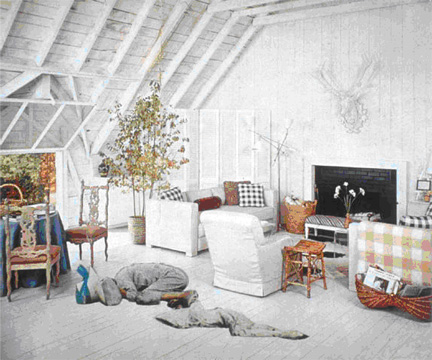About the Photographer
Rosler, Martha
American, b. 1943
Since the 1960s Martha Rosler's influential practice blends activism with aesthetics while using humor to convey challenging ideas. In varied works she addresses social issues such as the rituals of everyday life, the political nature of the domestic environment, women's experiences, and the uncertainties of representation, at times underscoring how these currents are interrelated. Although Rosler uses a wide range of mediums, she frequently turns to photography and video, drawing on the ways they relate to and reference mass culture.
Between 1967 and 1972 Rosler created Bringing the War Home, a series of collages that integrate photojournalistic images of the Vietnam war into photographs of idealized domestic interiors, clipped from popular magazines. In mainstream publications these two kinds of images were often printed on adjacent pages, yet they ostensibly represented distant and unrelated worlds. As Rosler knits together stark depictions of a supposedly foreign conflict and materialistic visions of a perfect American life, she creates the impression of a continuous space and suggests their interconnection. Rosler saw Bringing the War Home as an act of agitation and social commentary, and she originally conceived it for publication by underground presses and hand distribution, rather than for an art audience.
Nearly forty years later, in 2004, Rosler was struck by similarities between the war in Vietnam and the developing war in Iraq. Returning to the method of handcrafted collage—followed now by a scanning and printing process—she reprised the Bringing the War Home series, combining images from Iraq with contemporary interiors. Given the passing of four decades, the images register certain superficial changes, but Rosler's two sets of collages also call attention to a continuity in American policies and cultural practices. For the second series, she chose to release the works through a commercial gallery, aiming for greater public exposure. Given her established reputation, this approach facilitated the work's reproduction in publications with millions of subscribers.
As with her photocollages, Rosler's early Super-8 films "Backyard Economy I and II" (both 1974) deal with the politics of the domestic sphere and the ideologies that inform everyday life. More specifically, in both films the artist draws our attention to the labor that allows for leisure in the backyard. A lawn chair sporadically appears in the foreground in each film, but Rosler's point of interest is consistently elsewhere, lingering over arrangements of laundry hanging on a clothesline or following a woman as she completes various domestic tasks such as mowing the lawn.With cheap-looking production values, the films are in dialogue with broadcast television, but Rosler avoids the usual naturalism of narratives in popular culture. Influenced by the pioneering filmmaker Jean-Luc Godard, she uses representational strategies that destabilize the narrative and call the viewer's attention to how the medium is being used. In the "Backyard Economy" films, Rosler employs abrupt edits, inserts brief flashes of white for a slightly jarring effect, and at one moment spins the camera around rapidly, creating a rush of motion that makes it hard to see anything at all.
Martha Rosler was born in Brooklyn, New York in 1943. She received a B.A. from Brooklyn College (1965) and an M.F.A. from University of California, San Diego (1974). Rosler is also a respected critic, educator, and theorist.



